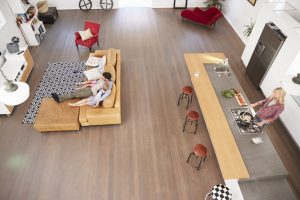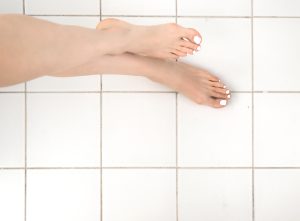The UK flooring market continues to evolve, reflecting changing lifestyle preferences, technological advances, and design trends that shape how we live and work. At Kent Flooring, we’ve observed significant shifts in customer preferences over recent years, with certain styles emerging as clear favourites across both residential and commercial sectors. Understanding these trends helps property owners make informed decisions that align with contemporary aesthetics whilst ensuring long-term satisfaction.
Current flooring trends reflect broader design movements towards natural materials, sustainability, and versatile spaces that accommodate modern living and working patterns. The pandemic’s impact on how we use our homes has also influenced flooring choices, with increased emphasis on comfort, durability, and easy maintenance.
Residential Flooring Trends
Wide Plank Wood-Look Flooring
Wide plank designs have become the dominant trend in UK homes, with planks ranging from 180mm to 250mm in width becoming increasingly popular. This trend reflects a desire for more natural, less busy appearances that create visual continuity and make spaces appear larger. Both genuine hardwood and luxury vinyl interpretations of wide plank designs are in high demand.
The preference for wider planks extends across all property types, from period homes where they complement traditional proportions to contemporary developments where they enhance minimalist design schemes. Oak remains the most requested species, but walnut and ash alternatives are gaining popularity amongst homeowners seeking distinctive character.
Natural and Light Oak Finishes
Light oak finishes dominate residential flooring choices, with natural, whitewashed, and limed oak effects proving particularly popular. These lighter tones complement the Scandinavian-inspired interiors that continue to influence UK home design. The appeal lies in their ability to brighten spaces, particularly important in British homes where natural light can be limited.
Grey-toned oak finishes experienced peak popularity several years ago but are now declining in favour of warmer, more natural tones. Homeowners are increasingly choosing finishes that age gracefully and won’t appear dated as trends evolve.
Luxury Vinyl Plank Dominance
Luxury vinyl plank (LVP) flooring has captured significant market share in UK homes due to its combination of authentic appearance, practical benefits, and competitive pricing. Modern LVP products offer remarkably realistic wood grain textures and colour variations that closely mimic genuine hardwood at a fraction of the cost.
The waterproof properties of luxury vinyl make it particularly suitable for British homes, where managing moisture from weather and lifestyle factors is a constant consideration. This practicality, combined with ease of maintenance, makes LVP especially popular with busy families and pet owners.
Herringbone and Chevron Patterns
Traditional parquet patterns, particularly herringbone and chevron designs, have experienced a remarkable resurgence in UK homes. These patterns add visual interest and sophistication to both period properties, where they honour historical precedent, and contemporary homes, where they create striking focal points.
The popularity of these patterns extends beyond genuine wood to luxury vinyl and laminate interpretations, making the look accessible across various budget ranges. Smaller-scale herringbone patterns are particularly popular in residential applications, offering pattern interest without overwhelming domestic-sized rooms.
Commercial Flooring Preferences
Industrial-Inspired Concrete Effects
Polished concrete and concrete-effect flooring have become increasingly popular in UK commercial spaces, particularly in creative industries, tech companies, and hospitality venues. This trend reflects the continued influence of industrial design aesthetics in commercial interiors.
Modern concrete-effect luxury vinyl products offer the visual appeal of polished concrete without the installation complexity and ongoing maintenance requirements. These products are particularly popular in restaurants, retail spaces, and contemporary offices seeking urban sophistication.
Large Format Tiles
Commercial spaces increasingly favour large format tiles, typically 600mm x 600mm or larger, including oversized rectangular formats. These larger tiles create seamless appearances with minimal grout lines, contributing to clean, modern aesthetics whilst simplifying maintenance routines.
Stone-effect porcelain tiles in neutral tones remain popular, with marble and granite effects particularly favoured in corporate environments and upscale retail spaces. The durability and low maintenance requirements of porcelain make it practical for high-traffic commercial applications.
Acoustic Solutions
Sound management has become a priority in UK commercial spaces, driving popularity for flooring solutions that address acoustic concerns. Commercial carpet tiles with enhanced sound absorption properties are increasingly specified in open-plan offices and co-working spaces.
Luxury vinyl products with acoustic backing and cork underlayments are also gaining traction as they provide hard surface durability whilst addressing noise concerns. This trend reflects changing workplace design priorities that emphasise employee comfort and productivity.
Cross-Sector Trends
Sustainability and Eco-Consciousness
Environmental considerations increasingly influence flooring choices across both residential and commercial sectors. Recycled content, low VOC emissions, and sustainable manufacturing processes are becoming significant selection criteria for environmentally conscious consumers and businesses pursuing green building certifications.
Bamboo flooring, whilst not yet mainstream, is gaining interest as awareness of its rapid renewable properties spreads. Similarly, cork flooring appeals to eco-conscious consumers seeking natural, sustainable alternatives to traditional materials.
Biophilic Design Influences
The biophilic design movement, which emphasises connections to nature, significantly impacts current flooring preferences. Natural wood grains, stone textures, and earth-tone colour palettes reflect this trend across both residential and commercial applications.
Even synthetic flooring products increasingly incorporate natural textures and organic patterns that connect occupants with natural environments. This trend extends beyond visual aesthetics to include tactile qualities that enhance the sensory experience of interior spaces.
Seamless Indoor-Outdoor Transitions
UK property owners increasingly seek flooring solutions that create seamless transitions between indoor and outdoor spaces. This trend drives popularity for materials that can withstand variable moisture conditions whilst maintaining consistent appearance and performance.
Luxury vinyl and porcelain tiles that replicate natural stone or wood are particularly popular for this application, offering durability in transitional spaces like conservatories, garden rooms, and covered outdoor areas.
Regional Variations
London and Urban Preferences
Metropolitan areas, particularly London, show stronger preferences for contemporary designs including polished concrete effects, large format tiles, and bold geometric patterns. Urban dwellers often embrace more experimental design choices and cutting-edge materials.
The trend towards smaller living spaces in urban areas also influences flooring choices, with light colours and continuous patterns preferred for their space-enhancing properties.
Rural and Traditional Areas
Rural areas and traditional market towns show stronger preferences for classic designs that complement period properties. Natural oak, traditional parquet patterns, and stone-effect materials that harmonise with local architectural styles remain popular choices.
These areas also show greater appreciation for genuine natural materials, with solid wood and natural stone maintaining stronger market positions compared to urban areas where synthetic alternatives are more readily accepted.
Emerging Trends
Digital Printing Advances
Technological improvements in digital printing continue to expand design possibilities, with increasingly sophisticated wood grains, stone textures, and even fabric effects becoming available in luxury vinyl and laminate products. These advances blur the distinction between natural and synthetic materials.
Wellness-Focused Features
Antimicrobial treatments, air-purifying properties, and ergonomic considerations increasingly influence flooring selection. These features reflect growing awareness of indoor environmental quality and its impact on health and wellbeing.
Customisation and Personalisation
Bespoke flooring solutions, including custom colours, patterns, and textures, are becoming more accessible through advanced manufacturing techniques. This trend reflects desires for unique, personalised interior environments that express individual style preferences.
Future Outlook
The UK flooring market continues evolving towards solutions that balance aesthetic appeal with practical performance. Sustainability concerns, technological advances, and changing lifestyle patterns will likely drive continued innovation in materials, manufacturing processes, and design options.
At Kent Flooring, we help clients navigate these trends whilst selecting solutions appropriate for their specific requirements, lifestyle, and budget considerations. Understanding current preferences provides valuable context, but the most successful flooring choices balance trending styles with individual needs and long-term satisfaction.
The key to successful flooring selection lies in choosing products that complement your space whilst providing the performance characteristics necessary for your specific application. Whether following current trends or creating timeless designs, quality materials and professional installation ensure satisfaction for years to come.




